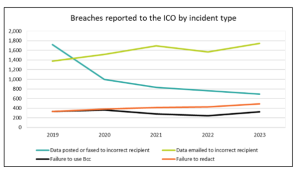October: Cyber Security Awareness Month 2024
Why Security Awareness and Training is Essential
Cyber threats are growing in frequency and sophistication, making it crucial for organisations to prioritise security awareness and training. While technology such as firewalls, antivirus software, and intrusion detection systems are important, they are not foolproof. Human error remains the leading cause of most security breaches, making it essential to ensure that all employees understand the role they play in protecting the organisation’s data and systems.
Please see some figures and data relating to breaches due to accidental human error.


The importance of security awareness and training cannot be stressed enough, with the benefits it brings to your organisation. An effective programme should be created that empowers your employees to be the first line of defence against cyber threats.
The Importance of Security Awareness and Training
The majority of security breaches are caused by human error. Whether it’s falling for a phishing scam, using weak passwords, or failing to follow proper procedures, employees can unknowingly create vulnerabilities that attackers exploit. Security awareness training educates staff on recognising and responding to potential threats, reducing the risk of errors that could lead to a breach.
Education establishments handle a wealth of sensitive data, from staff and student information to financial records, research data and intellectual property. A security breach can compromise this data, resulting in financial loss, reputational damage, and regulatory penalties. By equipping employees with the knowledge and skills to protect data, you can safeguard the assets and maintain trust.
Many industries are subject to stringent data protection regulations, such as GDPR. Failure to comply with these regulations can result in significant fines and legal consequences. Regular security awareness training ensures that employees understand their responsibilities regarding data protection and compliance, reducing the risk of regulatory violations.
Culture
A robust security culture starts with awareness. When employees understand the importance of cybersecurity and their role in protecting the organisation, they are more likely to adopt best practices and remain vigilant against potential threats. Training fosters a culture of shared responsibility, where everyone takes an active role in safeguarding the organisation.
Encourage employees to view cybersecurity as a core part of their daily responsibilities, rather than just an IT concern. Fostering a “security-first” mindset helps embed security awareness into the fabric of your culture.
Key Components of an Effective Security Awareness and Training Programme
Security awareness training should be an ongoing process, not a one-time event. Regular training sessions keep cybersecurity top of mind and ensure that employees are aware of the latest threats and best practices. These sessions can include a mix of in-person workshops, webinars, and e-learning modules to cater to different learning preferences. Annual training is proving to no longer be effective. While mandatory annual training is still required, the nudge theory allows awareness to be at the forefront of employees minds, steering and helping people make decisions that are in their best interest to develop a constant security conscious culture.
Using real-world scenarios in training helps employees understand the impact of their actions and the potential consequences of a security breach. For example, simulate phishing attacks to test employees’ ability to identify suspicious emails or create role-playing exercises that demonstrate how to handle sensitive data securely. It is key to create a no blame culture to ensure that staff won’t feel judged if they fail these exercises.
Employees need to know what is expected of them regarding cybersecurity. Make sure your organisation has clear, accessible policies and procedures that outline acceptable use, data handling practices, and incident reporting processes. Training should cover these policies in detail and provide employees with practical examples of how to apply them in their daily tasks.
People are more likely to retain information when it is presented in an engaging and interactive format. Use videos, quizzes, games, and interactive exercises to make training sessions more enjoyable and memorable. This approach not only helps employees retain key information but also encourages active participation.
Regularly assess the effectiveness of your training programme by gathering feedback from employees off the back of tests or quizzes to gauge their understanding. Use this feedback to identify areas for improvement and ensure that your training remains relevant and effective.
Leadership should be actively involved in promoting and supporting security awareness training. When leaders emphasise the importance of cybersecurity and model good behaviour, it sends a strong message to employees that security is a priority for the entire organisation.
Tips for Improving Security Awareness and Training
Different employees face different risks depending on their roles. Tailor your training to address the specific challenges and threats relevant to different departments, such as finance, HR, or IT.
Encourage employees to ask questions and share their concerns about security. Foster a culture where people feel comfortable reporting potential threats or suspicious activity without fear of retribution.
Recognise and reward employees who demonstrate good security practices. This could be through small incentives, public recognition, or other forms of positive reinforcement.
Analyse data from training assessments, incident reports, and other sources to identify trends and areas for improvement. Use this information to fine-tune your training programme and address specific weaknesses.
Designate cyber security champions in departments that have the knowledge of threats and best practices. It is common to feel sceptical about reporting incidents or asking questions of IT and having a known staff member to report to and champion best practices has proven to be successful.

Conclusion
Security awareness and training are essential components of any organisation’s cybersecurity strategy. By educating employees about the risks and their role in mitigating them, organisations can significantly reduce the likelihood of a security breach. An effective training programme fosters a security-first culture, protects sensitive data, ensures compliance with regulations, and ultimately enhances the overall security posture of the organisation.
Remember, cybersecurity is everyone’s responsibility. By investing in comprehensive security awareness training, you empower your employees to become a robust line of defence against ever-evolving cyber threats.
By adopting these best practices, you can strengthen your organisation’s resilience to cyber threats and build a workforce that is aware, vigilant, and prepared to protect the digital assets that are vital to your success.
————————————————————————————
And keep updated by joining the Jisc cyber community group. With more than 2,200 members, it’s a forum for sharing knowledge, best practice and threat intelligence for the benefit of the whole education and research sector.
Explore the latest cyber security technologies, innovations and future insights from both a national and international perspective at Jisc’s Security Conference 2024, 26-27 November, ICC Wales, and 28 November online.
